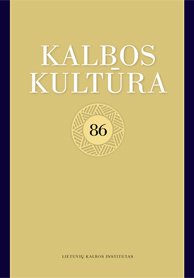Semantinė piniginių vienetų pavadinimų struktūra
Semantic Structure of Names of Currency Units
Author(s): Daiva MurmulaitytėSubject(s): Semantics, Baltic Languages
Published by: Lietuvių Kalbos Institutas
Keywords: semantics; semantic structure; meaning; shade of meaning; dictionary entry;
Summary/Abstract: With the exception of larger dictionaries of international words, the lexicographic sources of the Lithuanian language do not present the names of currency units comprehensively and systematically. Depending on dictionary purpose, scope, compiling methodology, etc., this lexical semantic group is presented differently in different dictionaries. The wordings of definitions of words are different (usually, certain conventional definitions are used); the actual usage is rarely illustrated; the presentation of semantic structure of such words varies as well.The summary of material from Lithuanian, Latvian, English, French, German, Russian and Polish dictionaries shows that the names of currency units have three meanings (or three shades of meaning): a currency unit of a specific country; the unit in terms of value compared to other currency units (only singular use); the cash form of its value (bank-note and/or coin).A small survey was carried out in the analysis of semantics of the names of currency units. Specialists of linguistics and third-year students of the study programme of Creative Industries were asked to indicate the meaning – whether currency unit or its cash form – in which the words litas and centas are used in the given examples of use. The analysis revealed that in theory, it is relatively easy for the respondents to distinguish between the two meanings; however, in specific cases, the answers of both linguists and the students of the aforementioned speciality to questionnaire questions were far from unanimous. Among other things, it prompts a conclusion that it is not always possible to distinguish between the said meanings. It can be explained by the fact that they are often provided as two shades of the same meaning. Nevertheless, the dictionary makes a distinction between them; it is also indicated by the different semantic valency of words. For example, in the sense of the currency unit, litas is used together with the words kursas (exchange rate), devalvuoti (to devalue), taupyti (to save), įvesti (to introduce), indėlis (a deposit), skolinti (to lend), etc., while in the sense of its cash form (bank-note, coin), it goes with suglamžyti (to crumple), suplėšyti (to tear apart); in turn – centas is used together with byrėti (to fall), baltas (white), sauja (handful), mesti (to toss), kišti (to slip into), riedėti (to roll), etc.In the absence of sufficient illustrative material, The Dictionary of Standard Lithuanian distinguishes at least two of the aforementioned shades – the first or the second and the third shade. The third shade of meaning is probably far enough from the first two shades to consider it an individual meaning. However, if we did not limit with the semantic group of names of currency units alone but also considered the distinction of meanings and shades in the context of the overall lexis of The Dictionary of Standard Lithuanian, it would apparently be appropriate to provide the semantic structure of currency units as shades, the more so that it is rather commonplace in the lexicographical practice – most of the dictionaries under analysis do not divide the currency unit and its cash form into two individual meanings (if it is recorded altogether).
Journal: Bendrinė kalba (iki 2014 metų – Kalbos kultūra)
- Issue Year: 2013
- Issue No: 86
- Page Range: 60-75
- Page Count: 16
- Language: Lithuanian

